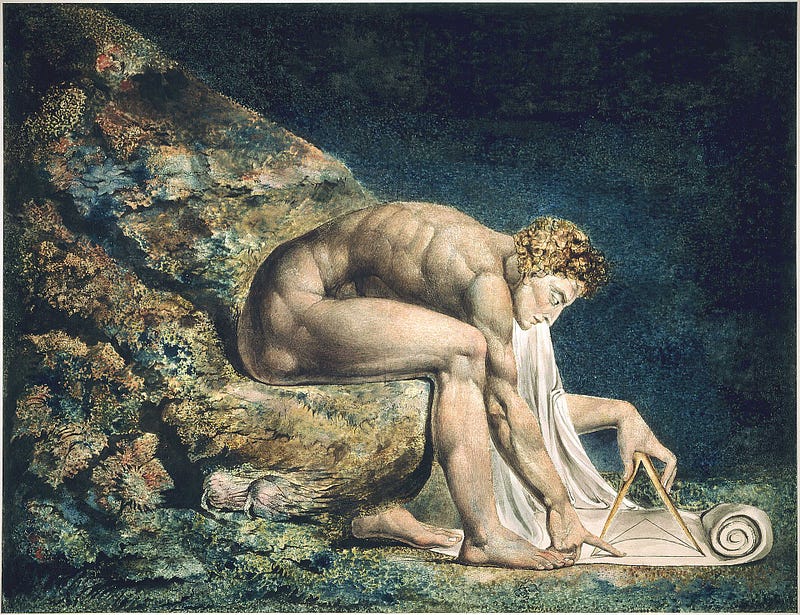William Blake: Visionary Poet of the 21st Century
Written on
The Artistic Legacy of William Blake
William Blake (1757–1827) serves as a voice and visionary for modern times. His poignant reflections resonate even today, as highlighted in his lines:
“And did the Countenance Divine,
Shine forth upon our clouded hills?
And was Jerusalem builded here,
Among these dark Satanic Mills?”
— William Blake, Milton: A Poem in Two Books
Recently, I found myself reflecting on the Luddite rebellion of the early 19th century. Shortly after, I came across an announcement in The London Review of Books for an exhibition at the Fitzwilliam Museum in Cambridge titled William Blake’s Universe. This exhibition presents an unprecedented collection of Blake's works from the Fitzwilliam alongside pieces from his European contemporaries, including German Romantic masters Philipp Otto Runge and Caspar David Friedrich, many of which have never before been showcased in the UK.
Notably, this exhibition participates in the Pay What You Wish initiative, aiming to make Blake’s genius accessible to those facing financial hardships. This context is particularly significant as it marks the first time Blake's work is placed within the broader landscape of European artistic movements. In a world riddled with crises, this exploration feels more relevant than ever.
The Luddites, through their direct actions, starkly illustrated the exploitative social conditions of their time, paralleling Blake's unique artistic responses to the dark transformations in England. Both movements, although different in approach, reveal a shared concern about the effects of mechanization on humanity. Today, we face a similar threat as the rise of machine intelligence looms large over our existence.
Despite being deemed eccentric by his contemporaries, Blake’s imaginative and philosophical depth has earned him admiration from later critics. It’s intriguing to consider not only Blake’s rightful place in the Romantic artistic movement but also the Luddite movement's alignment with European anti-Enlightenment ideologies.
Blake’s Early Life and Influences
Born on November 28, 1757, Blake came from a family of moderate means and enjoyed a peaceful childhood, largely free from formal education. My own journey with Blake began in primary school when I was tasked with memorizing The Tyger from his Songs of Experience:
“Tyger, tyger, burning bright,
In the forests of the night;
What immortal hand or eye,
Could frame thy fearful symmetry?”
— William Blake, 1794
Reciting this poem at our final school show sparked an early fascination, despite my youthful mind struggling to grasp its intricate themes about divine creation. It would take years for me to fully appreciate Blake's profound insights and his extraordinary body of work.
Blake's Philosophical Opposition
My affinity for Blake deepens with his critical stance against Enlightenment rationalism. He championed imagination as the essence of human experience, opposing the prevailing doctrines of rationalism and empiricism. His visionary spirituality often clashed with the Newtonian worldview, as reflected in his artwork Newton (1795), which critiques the limitations of scientific materialism.

“Art is the Tree of Life. Science is the Tree of Death,” Blake famously stated, illustrating the conflict between creative expression and the rigid structures of Enlightenment science. His depiction of Newton, a classical figure inspired by Michelangelo, embodies this tension, revealing the struggle between imagination and mechanistic thought.
Art and the Human Condition
Blake's artistic endeavors parallel the Luddite movement's resistance to the encroachment of machinery within capitalism. While the Luddites fought against economic exploitation through direct action, Blake wielded creativity as a tool for revolutionary expression. Both movements emerged from a shared awareness of a societal crisis, each advocating for a transformative response.
In this context, Blake’s mysticism serves as a counterpoint to the "single vision" of scientific materialism, critiquing the industrial landscape that gives rise to contemporary challenges, such as climate change.
The first video, William Blake vs the World: Why he matters more than ever, delves into Blake’s enduring relevance in today’s turbulent world, exploring how his vision can guide us through modern crises.
Contemporary Reflections
As we grapple with systemic economic challenges and geopolitical tensions like the ongoing war in Ukraine, Blake's insights resonate powerfully. The suppression of the Luddites echoes today’s struggles against increasing surveillance and restrictions on free speech, reminiscent of current movements for social justice and democracy.
The existential crisis facing Albion today mirrors the struggles of Blake's time, with dark forces challenging both spiritual and political realms. Yet, Blake offered hope over 200 years ago, suggesting that a better world, "Jerusalem," is still within our grasp.
“I will not cease from Mental Fight,
Nor shall my Sword sleep in my hand:
Till we have built Jerusalem,
In England's green & pleasant Land.”
— William Blake
The second video, William Blake: Poet, Artist & Visionary - a genius of early Romanticism in England, explores Blake's multifaceted genius and his significant contributions to literature and art.